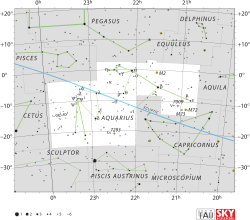Psi2 Aquarii

| |
| Observation data Epoch J2000 Equinox J2000 | |
|---|---|
| Constellation | Aquarius |
| Right ascension | 23h 17m 54.21372s[1] |
| Declination | –09° 10′ 57.0675″[1] |
| Apparent magnitude (V) | 4.403[2] |
| Characteristics | |
| Spectral type | B5 Vn[3] |
| U−B color index | –0.561[2] |
| B−V color index | –0.146[2] |
| Variable type | Periodic Be star |
| Astrometry | |
| Radial velocity (Rv) | -6[4] km/s |
| Proper motion (μ) | RA: +17.13[1] mas/yr Dec.: –11.70[1] mas/yr |
| Parallax (π) | 8.12 ± 0.38[1] mas |
| Distance | 400 ± 20 ly (123 ± 6 pc) |
| Details | |
| Radius | 4.6[5] R☉ |
| Temperature | 15,212 ± 288[5] K |
| Rotational velocity (v sin i) | 341[6] km/s |
| Other designations | |
Psi2 Aquarii is the Bayer designation for a star in the equatorial constellation of Aquarius. It is visible to the naked eye with an apparent visual magnitude of 4.4.[2] Based upon parallax measurements made during the Hipparcos mission, the distance to this star is roughly 400 light-years (120 parsecs).[1]
This is a B-type main sequence star with a stellar classification of B5 Vn.[3] The 'n' suffix indicates that the absorption lines in the spectrum are being broadened by Doppler shift from the star's rapid rotation rate. The projected rotational velocity of the star is 341 km/s.[6] Psi2 Aquarii is 4.6[5] times as large as the Sun with an effective temperature of 15,212 K[5] in its outer envelope.
It is a Lambda Eridani or periodic Be star with a pulsation cycle lasting 1.073 days.[8] The amplitude of the variation is 0.024 in magnitude.[9]
References
- 1 2 3 4 5 6 van Leeuwen, F. (November 2007), "Validation of the new Hipparcos reduction", Astronomy and Astrophysics, 474 (2): 653–664, arXiv:0708.1752
 , Bibcode:2007A&A...474..653V, doi:10.1051/0004-6361:20078357.
, Bibcode:2007A&A...474..653V, doi:10.1051/0004-6361:20078357. - 1 2 3 4 Kozok, J. R. (September 1985), "Photometric observations of emission B-stars in the southern Milky Way", Astronomy and Astrophysics Supplement Series, 61: 387–405, Bibcode:1985A&AS...61..387K.
- 1 2 Lesh, Janet Rountree (December 1968), "The Kinematics of the Gould Belt: an Expanding Group?", Astrophysical Journal Supplement, 17: 371, Bibcode:1968ApJS...17..371L, doi:10.1086/190179.
- ↑ Wilson, Ralph Elmer (1953), General Catalogue of Stellar Radial Velocities, Washington: Carnegie Institution of Washington, Bibcode:1953GCRV..C......0W.
- 1 2 3 4 Underhill, A. B.; et al. (November 1979), "Effective temperatures, angular diameters, distances and linear radii for 160 O and B stars", Monthly Notices of the Royal Astronomical Society, 189: 601–605, Bibcode:1979MNRAS.189..601U, doi:10.1093/mnras/189.3.601.
- 1 2 Bernacca, P. L.; Perinotto, M. (1970), "A catalogue of stellar rotational velocities", Contributi Osservatorio Astronomico di Padova in Asiago, 239 (1), Bibcode:1970CoAsi.239....1B.
- ↑ "93 Aqr -- Be Star", SIMBAD Astronomical Object Database, Centre de Données astronomiques de Strasbourg, retrieved 2012-07-06.
- ↑ Balona, L. A. (December 1995), "Tests of the Pulsation and Starspot Models for the Periodic Be-Stars", Monthly Notices of the Royal Astronomical Society, 277 (4): 1547, Bibcode:1995MNRAS.277.1547B, doi:10.1093/mnras/277.4.1547.
- ↑ Balona, L. A. (July 1990), "Short-period variability in Be stars", Monthly Notices of the Royal Astronomical Society, 245: 92–100, Bibcode:1990MNRAS.245...92B.